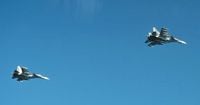Tensions in Eastern Europe soared this week as NATO fighter jets intercepted two Russian Su-30 warplanes armed with supersonic missiles over the Baltic Sea, a dramatic episode reflecting the region’s spiraling military brinkmanship. The incident, which took place on September 11, 2025, saw Swedish JAS 39 Gripen fighters, supported by Danish F-16s, scramble to confront the Russian aircraft—identified as Su-30SM and Su-30SM2 jets from Russia’s Baltic Fleet—after they were spotted flying in international airspace without transponders or flight plans. According to Daily Mail and Express, the Russian jets were equipped with Kh-31 anti-radiation missiles, weapons capable of reaching Mach 3 and designed to target ships and sophisticated air defense systems.
The Swedish Armed Forces, in a statement on social media, emphasized their readiness: “The Swedish Air Force is always on alert.” The interception, which also included the escorting away of a Russian Il-20M signals intelligence aircraft, was part of a routine NATO Quick Reaction Alert (QRA) response but carried added significance amid a series of recent provocations. The Il-20M, specialized in electronic and communications intelligence, was reportedly monitoring NATO networks, further heightening regional unease.
This was not an isolated event. The week prior, Swedish Gripens scrambled to intercept a similar Russian formation, including an Su-35, as reported by Express. These encounters unfolded against the backdrop of Russia’s Zapad-2025 joint military exercises with Belarus, a massive war game involving 20,000 troops, Iskander ballistic missiles, tactical nuclear simulations, hypersonic Oreshnik strikes, and amphibious assault drills. The Zapad-2025 drills, which concluded on September 16 after five days of simulated combat near Poland’s border, were described by Russian President Vladimir Putin as defensive maneuvers against “Western aggression.” Belarusian leader Alexander Lukashenko, meanwhile, hosted observers from the US, India, and other nations, highlighting the complex geopolitical alignments at play.
The military exercises unnerved NATO’s eastern flank. Poland, perceiving the drills as a direct threat, sealed its 418-mile border with Belarus on September 12, citing risks of hybrid warfare, including orchestrated migrant flows. The closure disrupted a £21 billion China-EU rail corridor, stranding thousands of tonnes of cargo and underscoring the economic fallout from mounting geopolitical tensions. As a precaution, Poland deployed 40,000 troops to its eastern border and authorized NATO’s “Eastern Sentry” mission, which included Danish F-16s, French Rafales, and German Eurofighters patrolling Baltic skies. Poland’s own IronDefender25 counter-drills brought together more than 30,000 troops from the Polish armed forces and allied NATO nations in Orzysz, Poland, aiming to enhance interoperability amid persistent risks.
Polish Prime Minister Donald Tusk didn’t mince words, warning that Europe is “closer to open conflict than since World War II,” and labeling Zapad-2025 “highly aggressive.” The sense of urgency only deepened following a string of airspace violations: on September 9, up to 23 Russian drones breached Polish territory; on September 13, Romania accused Moscow of violating its airspace, while Latvia reported a drone crash in its east. On September 15, a civilian drone was spotted flying over Warsaw’s presidential palace and government buildings, an incident Poland described as a “provocation.”
These incursions are not just isolated provocations—they form part of an escalating pattern that has put NATO on high alert. According to Daily Mail, NATO air policing, which averaged 300 intercepts annually before 2022, has surged fourfold since Russia’s invasion of Ukraine. NATO Secretary General Jens Stoltenberg stressed, “These are responses to unlawful flights.” Military analysts, such as retired British Colonel Hamish de Bretton-Gordon, have argued that the West’s earlier complacency may have emboldened Moscow. “We’ve given the impression we’re unconcerned. We must show resolve, or he’ll keep pushing,” de Bretton-Gordon told the Daily Mail.
Meanwhile, Russia’s war in Ukraine grinds toward its fourth year, and the skies over Eastern Europe remain a flashpoint. Ukrainian President Volodymyr Zelensky, in a statement on Telegram, reported that in the two weeks prior to September 17, Russia had launched more than 3,500 drones, over 2,500 powerful glide bombs, and nearly 200 missiles at targets inside Ukraine. Zelensky and Polish officials have repeatedly called for NATO to establish a no-fly zone over Ukraine, arguing that such a move would be a tangible demonstration of Western resolve and a deterrent to further Russian aggression.
“I’ve been calling for a no-fly zone in Ukraine against civilian targets and I believe NATO should do that,” de Bretton-Gordon said. “That sort of resolve will show to Putin that we are really, really serious here, and I don’t think we should be cowered by Medvedev and Peskov threatening World War III if we do that sort of stuff.” The calls for increased NATO involvement reflect a growing consensus among Eastern European leaders that the alliance must adapt to the new security reality on its eastern frontier.
Putin’s maneuvers, both in the air and on the ground, are widely seen as calculated intimidation—leveraging Belarus, now hosting Russian tactical nuclear weapons, to test NATO’s resolve and probe for weaknesses. The Zapad-2025 drills, with their simulated hypersonic and nuclear strikes, have only reinforced fears that routine patrols or minor incidents could escalate into a broader crisis. As Express reported, these exercises are not just about military readiness but also about sending a message to NATO and its allies that Moscow is prepared to defend its interests by any means necessary.
For its part, NATO has responded with a show of force and unity. The “Eastern Sentry” mission, with its multinational deployment of advanced fighter jets and naval assets, is intended to reassure member states and deter further aggression. At the same time, the alliance faces the delicate task of balancing deterrence with restraint, mindful that any miscalculation could tip the region into open conflict.
As the dust settles on the latest round of war games and interceptions, one thing is clear: the security landscape in Eastern Europe has fundamentally changed. With routine air patrols now potential flashpoints and political rhetoric growing sharper, the stakes for both sides have rarely been higher. The coming months will test NATO’s capacity for both vigilance and diplomacy as it navigates one of the most volatile periods in recent European history.




